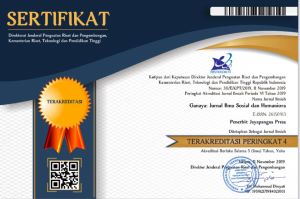Pengembangan Media Video Animasi Tematik Tema 4 Kewajiban dan Hakku Untuk Siswa Kelas III Sekolah Dasar
DOI:
https://doi.org/10.37329/cetta.v7i1.3135Keywords:
Animation Video, Learning Media, 4D ModelAbstract
Learning media is an important tool in the learning process which functions to achieve learning goals. The lack of availability of interesting learning media in elementary schools causes learning to become monotonous. This research aims to determine the process of developing animated video media and the validity of animated video media. This research method is development research using the 4D model, namely define, design, development and dissemination. The resulting learning media is animated video media for theme 4, my obligations and rights, subtheme 1, my obligations and rights, learning 1. The validity of animated video media received a very valid category without revision, reviewed based on validation results by material experts, language experts and design experts. In the material aspect, the average score was 94.56% in the very valid category, in the language aspect, the average score was 93.33% in the very valid category, and in the design aspect, the average score was 100% in the very valid category.
References
Awalia, I., Pamungkas, A. S., & Alamsyah, T. P. (2019). Pengembangan Media Pembelajaran Animasi Powtoon pada Mata Pelajaran Matematika di Kelas IV SD. Kreano, Jurnal Matematika Kreatif-Inovatif, 10(1), 49–56.
Azimah, N., & Febrina Dafit. (2022). Pengembangan Media Lift the Flap Book pada Pembelajaran Tematik Kelas 1 Sekolah Dasar. Jurnal Ilmiah Pendidikan Profesi Guru, 5(2), 372–382.
Fakhrurrazi, F. (2018). Hakikat Pembelajaran Yang Efektif. At-Tafkir, 11(1), 85–99.
Gamayanti, W., & Gisala Marzuq, F. (2021). Media Animasi dalam Meningkatkan Motivasi Pembelajaran Bahasa Inggris pada Masa Pandemi Covid-19. Proceedings UIN Sunan Gunung Djati Bandung, 1(59), 1–10.
Hanafi. (2017). Konsep Penelitian R&D Dalam Bidang Pendidikan. Jurnal Kajian Keislaman, 4(2), 129–150.
Johan, J. R., Iriani, T., & Maulana, A. (2023). Penerapan Model Four-D dalam Pengembangan Media Video Keterampilan Mengajar Kelompok Kecil dan Perorangan. Jurnal Pendidikan West Science, 01(06), 372–378.
Johari, A., Hasan, S., & Rakhman, M. (2016). Penerapan Media Video Dan Animasi Pada Materi Memvakum Dan Mengisi Refrigeran Terhadap Hasil Belajar Siswa. Journal of Mechanical Engineering Education, 1(1), 8.
Mulyadi, Fahreza, F., & Julianda, R. (2018). Penggunaan Media Audio Visual Untuk Meningkatkan Prestasi Belajar Pada Pembelajaran IPS Siswa Kelas V SDN Langung. Jurnal Visipena, 9(1), 131–146.
Nurrita, T. (2018). Pengembangan Media Pembelajaran Untuk Meningkatkan Hasil Belajar Siswa. MISYKAT: Jurnal Ilmu-Ilmu Al-Quran, Hadist, Syari’ah Dan Tarbiyah, 3(1), 171.
Okpatrioka. (2023). Research And Development ( R & D ) Penelitian Yang Inovatif Dalam Pendidikan. Jurnal Pendidikan, Bahasa Dan Budaya, 1(1), 86–100.
Riefani, M. K. (2020). Validitas Dan Kepraktisan Panduan Lapangan “Keragaman Burung” Di Kawasan Pantai Desa Sungai Bakau. Vidya Karya, 34(2), 193.
Rozie, F. (2018). Persepsi guru sekolah dasar tentang penggunaan media pempelajaran sebagai alat bantu pencapaian tujuan pembelajaran. Widyagogik: Jurnal Pendidikan Dan Pembelajaran Sekolah Dasar, 5(2), 1–12.
Setiyawan, H. (2021). Pemanfaatan Media Audio Visual dan Media Gambar Pada Siswa Kelas V. Jurnal Prakarsa Paedagogia, 3(2), 198–203.
Suwarti, S., Laila, A., & Permana, E. P. (2020). Pengembangan Media Komik Berbasis Kearifan Lokal untuk Menentukan Pesan dalam Dongeng pada Siswa Sekolah Dasar. Profesi Pendidikan Dasar, 7(2), 140–151.
Widiyasari, R., Astriyani, A., & Irawan, K. V. (2020). Pengembangan Perangkat Pembelajaran Matematika Dengan Bantuan Media Evaluasi Thatquiz. FIBONACCI: Jurnal Pendidikan Matematika Dan Matematika, 6(2), 131.
Winda, R., & Dafit, F. (2021). Analisis Kesulitan Guru dalam Penggunaan Media Pembelajaran Online di Sekolah Dasar. Jurnal Pedagogi Dan Pembelajaran, 4(2), 211.
Wisada, P. D., Komang Sudarma, I., & Wayan Ilia Yuda S, I. (2019). Pengembangan Media Video Pembelajaran Berorientasi Pendidikan Karakter. Journal of Education Technology, 3(3), 140–146.
Downloads
Published
How to Cite
Issue
Section
License
Copyright (c) 2024 Mersi Amalia, Zaka Hadikusuma Ramadan

This work is licensed under a Creative Commons Attribution-ShareAlike 4.0 International License.
An author who publishes in the Cetta : Jurnal Ilmu Pendidikan agrees to the following terms:
- Author retains the copyright and grants the journal the right of first publication of the work simultaneously licensed under the Creative Commons Attribution-ShareAlike 4.0 License that allows others to share the work with an acknowledgement of the work's authorship and initial publication in this journal
- Author is able to enter into separate, additional contractual arrangements for the non-exclusive distribution of the journal's published version of the work (e.g., post it to an institutional repository or publish it in a book) with the acknowledgement of its initial publication in this journal.
- Author is permitted and encouraged to post his/her work online (e.g., in institutional repositories or on their website) prior to and during the submission process, as it can lead to productive exchanges, as well as earlier and greater citation of the published work (See The Effect of Open Access).
Read more about the Creative Commons Attribution-ShareAlike 4.0 Licence here: https://creativecommons.org/licenses/by-sa/4.0/.





